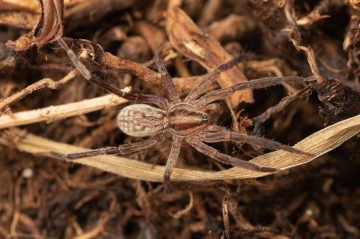Summary for Zora silvestris (Araneae)
previous species | next species
National Distribution
Terms of Use. Double-click on map to go to region

Explore Regional Distribution
Please log on and add a note on this species
About this species
Recorded altitude range50m to 91m
Species text
DistributionThe species has been recorded from Hurt Wood, Surrey, in 1953; Iken Heath, East Suffolk, in 1955; Ambersham Common, West Sussex, in 1969; Sherwood Forest Country Park, Nottinghamshire, in 1987 and from north-east Hampshire. It is widespread in north-western and central Europe as far north as Sweden, but has not been recorded from Ireland.
Habitat and ecology
In Britain, Z. silvestris occurs on dry heathland, mainly in mature heather. In Sherwood Forest it was found with larger numbers of Z. spinimana in mixed heather and grassland from which encroaching scrub and trees had been cleared. Both sexes are found from May to July and a female has been recorded in September.
Status
The spider is apparently rare but may have been overlooked owing to its similarity to the widespread and abundant Z. spinimana. It has only been found in very small numbers. Several specimens were found at Hurt Wood and Sherwood Forest but it has only been recorded from one 10 km square post-1992. It shows a decline of 75% in the area of occupancy from four hectads before 1992 to just one since that date.
Threats
Fires in the mature heather habitat are a threat to this species. Management to reduce the fire risk by preventing the heather reaching the mature phase, such as by grazing or burning on a short rotation, is often used on nature reserves, but would probably result in very little heather being at the desired stage for this spider. Small unmanaged areas rapidly succumb to scrub encroachment, with loss of heather. Heathlands are also at risk from urban expansion and conversion to arable land. Motorcycle scrambling may cause damage to areas of heath and where sites are close to the roadside, there is risk from traffic pollution, road salt and roadworks.
Management and conservation
Scrub and tree clearance to restore heathland should ideally be followed by a grazing regime which will maintain the heathland vegetation at a variety of heights.
Text based on Dawson, I.K., Harvey, P.R., Merrett, P. & Russell-Smith, A.R. (in prep.). References
Adult Season
Habitats
background methodology
Recorded management for locations with Zora silvestris
Recorded substrate and hydrology for locations with Zora silvestris
Images
please log on and upload a new image for this speciesSee also A-Z Species Index - A-Z Picture Index - previous species | next species
